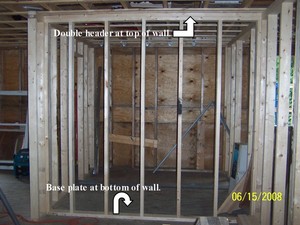Suspended ceilings are common in basements where overhead obstacles make installing a standard ceiling impractical. They have also gained popularity in other areas of the home as the choices for patterns, designs and colors have expanded. These ceilings are relatively easy to install, durable, and can be very attractive.
Begin by installing the brackets on all exterior walls. Mark the level at which you want the lowest portion of the ceiling. Use a long carpenter’s level to continue making marks along this same height for the full perimeter of the room. Install the ‘L’ brackets to the wall by screwing them into the wall studs. In most walls the studs will be on 16 inch centers. Install full 10 foot length of bracket first, then cut the needed shorter pieces. Periodically check these brackets as they are installed to be certain they are remaining level.
Measure out four feet from an exterior wall. Make additional marks every four feet across the full width of the room. Directly above each of these lines install eye bolts into the overhead joists. You will need to install one eye bolt every 36 inches. These will serve as your anchor points for your hanger wires.
Install the hanger wires on eye of the eye bolt anchors. Twist one end of the hanger wire tightly around the eye bolt and allow the other end to hang down 6 to 8 inches below the level of the exterior L bracket.
Clip the main ‘T’ bracket into the ‘L’ bracket at the four foot mark. Slowly work your way across the room fastening the hanger wires to the ‘T’ bracket. Use the level to keep these brackets level as you work your way across the room. Repeat this process for each row of ‘T’ brackets.
Begin in one corner of the room and install the short ‘T’ brackets every 2 feet between the long sections of ‘T’ brackets. These brackets are 4 feet in length and shaped identical to the main ‘T’ brackets you just installed. When completed you should have a grid-work of 2 foot by 4 foot openings. These brackets should snap into place in pre-drilled holes in the brackets.
Unless your room is devisable by four, your will have one row which will be an odd length. Take careful measurements and cut a ‘T’ bracket to fit this opening. Clip these custom length ‘T’ brackets into place to complete the grid.
Again starting in one corner, begin installing the ceiling panels. You will need to angle these slightly to insert them through the grid-work. Once above the grid-work level the panel and allow it to drop into place. Work your way across the room until all tiles are installed with the exception of the odd sized row.
Take careful measurements of each opening and cut ceiling tiles to the proper length. Install each tile before cutting the next. While each tile should be the same length, any variance in the rooms width could cause this measurement to change slightly. Cut the tiles with a razor blade cutter, Once all custom tiles are installed the ceiling is complete. You may now begin the more complicated task of installing lights or other features such as a ceiling fan.



